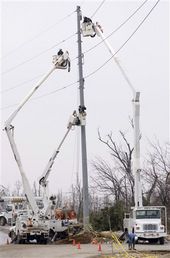Thousands of people in ice-caked Kentucky awoke in motels and shelters, asked to leave their homes by authorities who said emergency teams in some areas were too strapped to reach everyone in need of food, water and warmth.
A 20-degree temperature boost was forecast across much of the region, a boon to the power crews but one that carried with it the threat of flooding.
Dozens of deaths have been reported and many people are pleading for a faster response to the power outages. About 536,000 homes and businesses across Kentucky were without power, down from more than 600,000, the largest outage in state history.
The outages disabled water systems in much of the western part of the state, where some in rural areas resorted to dipping buckets in a creek. Authorities warned it could be days or weeks before power was restored in the most remote spots.

That uncertainty had many appealing for help and officials urging those in dark homes to leave, if they could - many were stuck in place by blocked roads and other obstacles. The Ohio River city of Paducah, one of the largest communities in hard-hit western Kentucky, issued an overnight curfew for its 25,000 residents.
"We're asking people to pack a suitcase and head south and find a motel if they have the means, because we can't service everybody in our shelter," said Crittenden County Judge-Executive Fred Brown, who oversees about 9,000 people, many of whom spent a fifth night sleeping in the town's elementary school.
Local officials grew angrier at what they said was a lack of help from the state and the Federal Emergency Management Agency.
In Kentucky's Grayson County, about 80 miles southwest of Louisville, Emergency Management Director Randell Smith said the 25 National Guardsmen who have responded have no chain saws to clear fallen trees.
"We've got people out in some areas we haven't even visited yet," Smith said. "We don't even know that they're alive."
Smith said FEMA was still a no-show days after the storm.
"I'm not saying we can't handle it," Smith said. "We're handling it. But it sure would have made life a lot easier."
FEMA spokeswoman Mary Hudak said some agency workers had begun working Friday in Kentucky and more help was on the way. Hudak said FEMA also has shipped 50 to 100 generators to the state to supply electricity to such facilities as hospitals, nursing homes and water treatment plants.
"We have plenty of folks ready to go, but there are some limitations with roads closed and icy conditions," she noted.
The storm that began in the Midwest had been blamed or suspected in at least 42 deaths, including 11 in Kentucky, nine in Arkansas, six each in Texas and Missouri, three in Virginia, two each in Oklahoma, Indiana and West Virginia and one in Ohio. Most were blamed on hypothermia, traffic accidents and carbon monoxide poisoning.
President Barack Obama declared a federal emergency Friday for Missouri, making the state eligible for federal funds even as power outages lingered in much of the southern portion of the state.
Kentucky Gov. Steve Beshear said crews were working around the clock to restore power and get food and water to needed areas.
"We are pulling out all the stops, using all of our resources and devoting our entire energy to this emergency and we will continue to do so until the last home has power, the last road is cleared and the last family is safe," Beshear said.
Laura Howe, a spokeswoman for the American Red Cross, said the organization had opened more than 34 shelters for some 2,000 people.
From Missouri to Ohio, thousands were waiting in shelters for the power to return. Others were trying to tough it out at home.
Doris Hemingway, 78, spent three days bundled in blankets to ward off the cold in her Leitchfield mobile home. News that it could take up to six weeks for power to be restored sent Hemingway and her husband, Bill, into a shelter at a local high school.
"I'd pray awhile and I'd cry awhile," Doris Hemingway said. "It's the worst I've ever seen."



Reader Comments
to our Newsletter